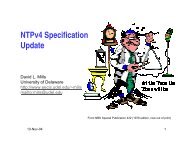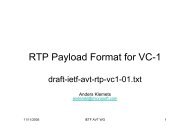TRILL over IP
TRILL over IP
TRILL over IP
Create successful ePaper yourself
Turn your PDF publications into a flip-book with our unique Google optimized e-Paper software.
<strong>TRILL</strong> <strong>over</strong> <strong>IP</strong><br />
draft-mrw-trill-<strong>over</strong>-ip-00.txt<br />
Margaret Wasserman <br />
Donald Eastlake <br />
Dacheng Zhang
<strong>TRILL</strong> <strong>over</strong> <strong>IP</strong> Basics<br />
<strong>TRILL</strong> Protocol defined in RFCs 6325, 6326 & 6327<br />
<strong>TRILL</strong> is already defined to work <strong>over</strong> different link<br />
layer types, both multicast and point-to-point<br />
Ethernet (RFC 6325) & PPP (RFC 6361)<br />
<strong>TRILL</strong> <strong>over</strong> <strong>IP</strong> defines how <strong>TRILL</strong> can be run <strong>over</strong><br />
UDP/<strong>IP</strong><br />
<strong>TRILL</strong> packets are encapsulated in UDP/<strong>IP</strong>(v4 or v6),<br />
and sent <strong>over</strong> any <strong>IP</strong> network<br />
Very simple encapsulation, does not modify <strong>TRILL</strong>
<strong>TRILL</strong> <strong>over</strong> <strong>IP</strong> Scenarios<br />
Remote Office Scenario<br />
Nodes in a remote office are connected to a central<br />
<strong>TRILL</strong> campus <strong>over</strong> a multi-hop network, possibly the<br />
public Internet<br />
<strong>IP</strong> Backbone Scenario<br />
<strong>TRILL</strong> links within an enterprise network are<br />
connected, as a single <strong>TRILL</strong> campus, <strong>over</strong> an <strong>IP</strong><br />
backbone
Remote Office Scenario<br />
Remote<br />
Office<br />
RB<br />
Remote<br />
Office<br />
RB<br />
RB<br />
RB<br />
Main <strong>TRILL</strong> Campus<br />
Pairs (or small sets?) of RBridges used to connect remote offices to a<br />
central <strong>TRILL</strong> Campus<br />
<strong>TRILL</strong> <strong>over</strong> <strong>IP</strong> links run across multi-hop networks (such as the public<br />
Internet). May not be under the same administrative control as the<br />
<strong>TRILL</strong> campus, may not support multicast.
<strong>IP</strong> Backbone Scenario<br />
<strong>TRILL</strong> <strong>over</strong> <strong>IP</strong> Backbone<br />
RB RB RB<br />
<strong>TRILL</strong> Links<br />
Multiple <strong>TRILL</strong> links within a single campus, connected using a <strong>TRILL</strong><br />
<strong>over</strong> <strong>IP</strong> backbone<br />
The <strong>TRILL</strong> <strong>over</strong> <strong>IP</strong> link is part of the <strong>TRILL</strong> campus. Multiple (even<br />
many?) RBridges may be on a single <strong>TRILL</strong> <strong>over</strong> <strong>IP</strong> link, and the link will<br />
typically support multicast
Key Differences: Security<br />
In Remote Office Scenario, <strong>TRILL</strong> <strong>over</strong> <strong>IP</strong> traffic will<br />
be tunneled <strong>over</strong> links that may not be in the same<br />
administrative control as the <strong>TRILL</strong> campus.<br />
Authentication and authorization of remote<br />
Rbridges, and data privacy are major concerns.<br />
In <strong>IP</strong> Backbone Scenario, the <strong>IP</strong> link runs <strong>over</strong> links<br />
with the same security properties as the <strong>TRILL</strong> links,<br />
so no additional security is needed for parity with<br />
L2 switching solutions (<strong>TRILL</strong> or others)
Key Differences: Multicast<br />
In the <strong>IP</strong> Backbone scenario, the <strong>TRILL</strong> <strong>over</strong> <strong>IP</strong><br />
backbone link will typically support multicast, and<br />
multicast support is highly desirable to allow<br />
Rbridges to disc<strong>over</strong> adjacencies.<br />
In Remote Office Scenario, multicast is probably not<br />
supported across the <strong>TRILL</strong> <strong>over</strong> <strong>IP</strong> link, and<br />
automatic disc<strong>over</strong>y of adjacencies is not desirable<br />
(due to security concerns).
<strong>TRILL</strong> Frame Formats<br />
<strong>TRILL</strong> Data Frame (Generic Format):<br />
Data Link <strong>TRILL</strong> Encapsulated Link<br />
Header Header Native Frame Trailer<br />
<strong>TRILL</strong> IS-IS Frame (Generic Format):<br />
<strong>TRILL</strong> IS-IS <strong>TRILL</strong> IS-IS Link<br />
Link Header Payload Trailer<br />
UDP port numbers are allocated for each of the<br />
above frame types.<br />
In <strong>TRILL</strong> <strong>over</strong> <strong>IP</strong>, the link header is UDP/<strong>IP</strong> and<br />
there is no Link Trailer
<strong>TRILL</strong> <strong>over</strong> UDP/<strong>IP</strong><br />
<strong>TRILL</strong> is encapsulated in UDP/<strong>IP</strong> (<strong>IP</strong>v4 or <strong>IP</strong>v6)<br />
<strong>IP</strong> provides addressing, ability to route packets across<br />
a multi-hop <strong>IP</strong> network<br />
UDP provides checksum (when needed) and ports to<br />
disambiguate <strong>TRILL</strong><br />
<strong>IP</strong>(v4 or v6) UDP <strong>TRILL</strong><br />
Header Header Payload
Security<br />
In cases where authentication, authorization and<br />
data privace are required (like the Remote Office<br />
Scenario), this is accomplished using DTLS.<br />
DTLS does not support multicast, so in the secure<br />
case, all traffic between <strong>TRILL</strong> <strong>over</strong> <strong>IP</strong> Rbridges is<br />
unicast (multicast is serialized, when necessary).<br />
Note: Use of DTLS security is not mutually<br />
exclusive with the use of IS-IS security.
Multicast<br />
There are cases where data privacy is not needed on<br />
the <strong>TRILL</strong> <strong>over</strong> <strong>IP</strong> link, and multicast is highly<br />
desirable for efficiency (such as the <strong>IP</strong> Backbone<br />
Scenario).<br />
In this cases, multicast is supported, and <strong>IP</strong>v4 and<br />
<strong>IP</strong>v6 “All-Rbridges” multicast addresses are<br />
allocated.<br />
<strong>IP</strong>v4: 233.252.14.0<br />
<strong>IP</strong>v6: FF0X:0:0:0:0:0:0:205
Next Steps<br />
Comments or questions?<br />
Is the WG interested in adopting this work as a WG<br />
work item?<br />
Document will be updated to address the feedback<br />
we’ve received, so far. Thank you!



